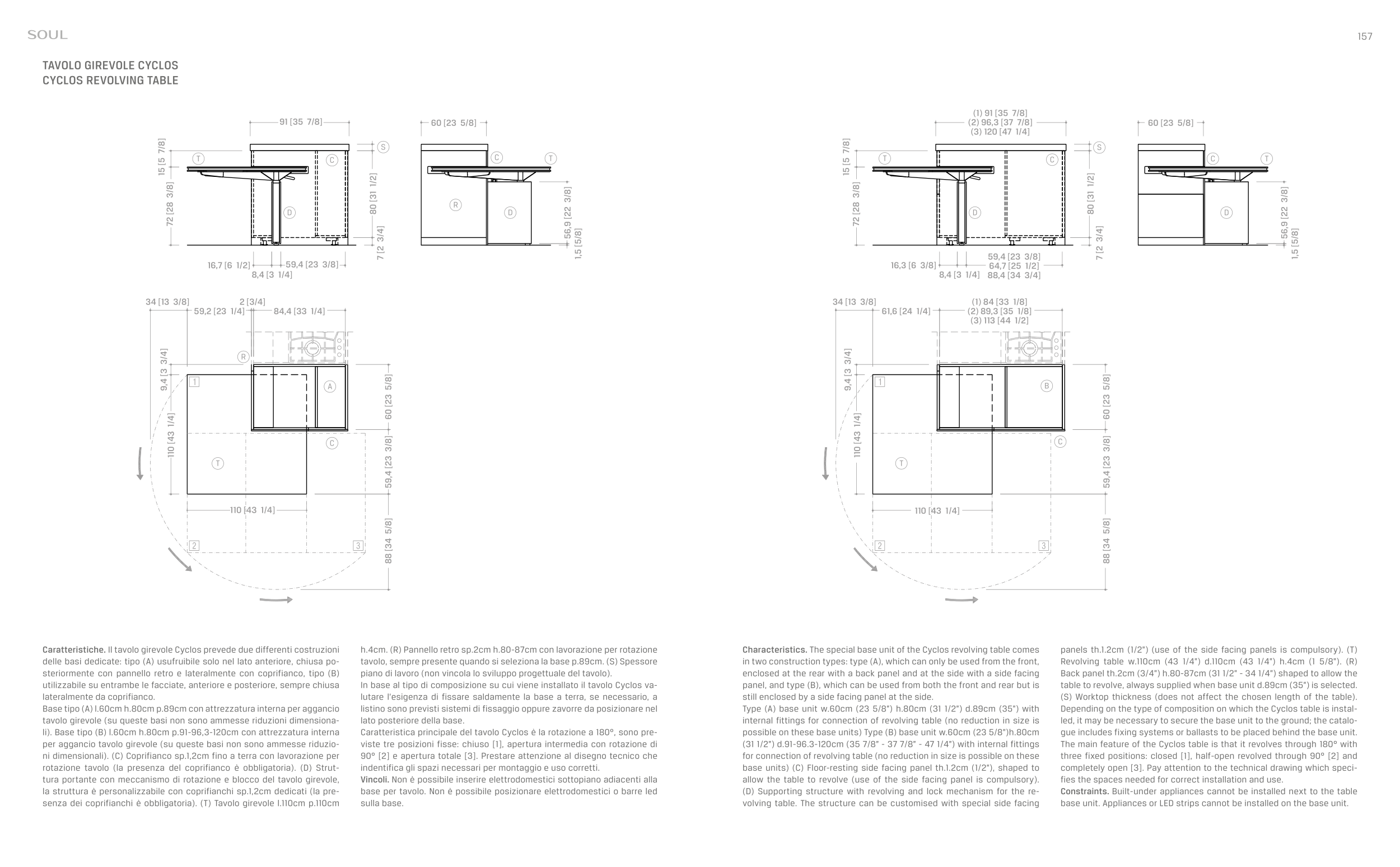157
SOUL
Caratteristiche. Il tavolo girevole Cyclos prevede due differenti costruzioni
delle basi dedicate: tipo (A) usufruibile solo nel lato anteriore, chiusa po-
steriormente con pannello retro e lateralmente con coprifianco, tipo (B)
utilizzabile su entrambe le facciate, anteriore e posteriore, sempre chiusa
lateralmente da coprifianco.
Base tipo (A) l.60cm h.80cm p.89cm con attrezzatura interna per aggancio
tavolo girevole (su queste basi non sono ammesse riduzioni dimensiona-
li). Base tipo (B) l.60cm h.80cm p.91-96,3-120cm con attrezzatura interna
per aggancio tavolo girevole (su queste basi non sono ammesse riduzio-
ni dimensionali). (C) Coprifianco sp.1,2cm fino a terra con lavorazione per
rotazione tavolo (la presenza del coprifianco è obbligatoria). (D) Strut-
tura portante con meccanismo di rotazione e blocco del tavolo girevole,
la struttura è personalizzabile con coprifianchi sp.1,2cm dedicati (la pre-
senza dei coprifianchi è obbligatoria). (T) Tavolo girevole l.110cm p.110cm
h.4cm. (R) Pannello retro sp.2cm h.80-87cm con lavorazione per rotazione
tavolo, sempre presente quando si seleziona la base p.89cm. (S) Spessore
piano di lavoro (non vincola lo sviluppo progettuale del tavolo).
In base al tipo di composizione su cui viene installato il tavolo Cyclos va-
lutare l’esigenza di fissare saldamente la base a terra, se necessario, a
listino sono previsti sistemi di fissaggio oppure zavorre da posizionare nel
lato posteriore della base.
Caratteristica principale del tavolo Cyclos è la rotazione a 180°, sono pre-
viste tre posizioni fisse: chiuso [1], apertura intermedia con rotazione di
90° [2] e apertura totale [3]. Prestare attenzione al disegno tecnico che
indentifica gli spazi necessari per montaggio e uso corretti.
Vincoli. Non è possibile inserire elettrodomestici sottopiano adiacenti alla
base per tavolo. Non è possibile posizionare elettrodomestici o barre led
sulla base.
T
T
D
D
D
R
R
D
C
C
C
C
A
S
T
T
B
C
T
C
T
S
91 [35 7/8]
34 [13 3/8]
34 [13 3/8]
9,4 [3 3/4]
9,4 [3 3/4]
110 [43 1/4]
110 [43 1/4]
110 [43 1/4]
110 [43 1/4]
59,2 [23 1/4]
61,6 [24 1/4]
84,4 [33 1/4]
2 [3/4]
16,7 [6 1/2]
16,3 [6 3/8]
8,4 [3 1/4]
8,4 [3 1/4]
59,4 [23 3/8]
59,4 [23 3/8]
64,7 [25 1/2]
88,4 [34 3/4]
(1) 91 [35 7/8]
(2) 96,3 [37 7/8]
(3) 120 [47 1/4]
(1) 84 [33 1/8]
(2) 89,3 [35 1/8]
(3) 113 [44 1/2]
59,4 [23 3/8]
59,4 [23 3/8]
88 [34 5/8]
88 [34 5/8]
60 [23 5/8]
60 [23 5/8]
60 [23 5/8]
60 [23 5/8]
56,9 [22 3/8]
1,5 [5/8]
56,9 [22 3/8]
1,5 [5/8]
15 [5 7/8]
15 [5 7/8]
72 [28 3/8]
72 [28 3/8]
80 [31 1/2]
80 [31 1/2]
7 [2 3/4]
7 [2 3/4]
TAVOLO GIREVOLE CYCLOS
CYCLOS REVOLVING TABLE
Characteristics. The special base unit of the Cyclos revolving table comes
in two construction types: type (A), which can only be used from the front,
enclosed at the rear with a back panel and at the side with a side facing
panel, and type (B), which can be used from both the front and rear but is
still enclosed by a side facing panel at the side.
Type (A) base unit w.60cm (23 5/8”) h.80cm (31 1/2”) d.89cm (35”) with
internal fittings for connection of revolving table (no reduction in size is
possible on these base units) Type (B) base unit w.60cm (23 5/8”)h.80cm
(31 1/2”) d.91-96.3-120cm (35 7/8” - 37 7/8” - 47 1/4”) with internal fittings
for connection of revolving table (no reduction in size is possible on these
base units) (C) Floor-resting side facing panel th.1.2cm (1/2”), shaped to
allow the table to revolve (use of the side facing panel is compulsory).
(D) Supporting structure with revolving and lock mechanism for the re-
volving table. The structure can be customised with special side facing
panels th.1.2cm (1/2”) (use of the side facing panels is compulsory). (T)
Revolving table w.110cm (43 1/4”) d.110cm (43 1/4”) h.4cm (1 5/8”). (R)
Back panel th.2cm (3/4”) h.80-87cm (31 1/2” - 34 1/4”) shaped to allow the
table to revolve, always supplied when base unit d.89cm (35”) is selected.
(S) Worktop thickness (does not affect the chosen length of the table).
Depending on the type of composition on which the Cyclos table is instal-
led, it may be necessary to secure the base unit to the ground; the catalo-
gue includes fixing systems or ballasts to be placed behind the base unit.
The main feature of the Cyclos table is that it revolves through 180° with
three fixed positions: closed [1], half-open revolved through 90° [2] and
completely open [3]. Pay attention to the technical drawing which speci-
fies the spaces needed for correct installation and use.
Constraints. Built-under appliances cannot be installed next to the table
base unit. Appliances or LED strips cannot be installed on the base unit.
T
T
D
D
D
R
R
D
C
C
C
C
A
S
T
T
B
C
T
C
T
S
91 [35 7/8]
34 [13 3/8]
34 [13 3/8]
9,4 [3 3/4]
9,4 [3 3/4]
110 [43 1/4]
110 [43 1/4]
110 [43 1/4]
110 [43 1/4]
59,2 [23 1/4]
61,6 [24 1/4]
84,4 [33 1/4]
2 [3/4]
16,7 [6 1/2]
16,3 [6 3/8]
8,4 [3 1/4]
8,4 [3 1/4]
59,4 [23 3/8]
59,4 [23 3/8]
64,7 [25 1/2]
88,4 [34 3/4]
(1) 91 [35 7/8]
(2) 96,3 [37 7/8]
(3) 120 [47 1/4]
(1) 84 [33 1/8]
(2) 89,3 [35 1/8]
(3) 113 [44 1/2]
59,4 [23 3/8]
59,4 [23 3/8]
88 [34 5/8]
88 [34 5/8]
60 [23 5/8]
60 [23 5/8]
60 [23 5/8]
60 [23 5/8]
56,9 [22 3/8]
1,5 [5/8]
56,9 [22 3/8]
1,5 [5/8]
15 [5 7/8]
15 [5 7/8]
72 [28 3/8]
72 [28 3/8]
80 [31 1/2]
80 [31 1/2]
7 [2 3/4]
7 [2 3/4]


